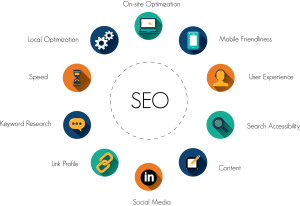Connect with us
Recent Posts
-
How do I get Links for My Website?
In our last link related post, we listed the types of links you can use to increase traffic to your site, and defined each type. Now we are going to cover how to add links and where to go for more. The listing of these links is different from the previous post, as they follow here in order of how easy they are to obtain rather than level of importance.
Internal links are the type you put in yourself. They can take you to the top of the current page, to the home page, or to one of several relevant pages within your website. You add these simply by putting a simple HTML tag in the text of your page, such as:
<a href=“(enter url)”> link name</a>
‘Enter url’ is just a copy and paste; go to the page you want to link to, copy the url and past it between the quotation marks. ‘Link name’ is what will be visible for the viewer to click on: “Click Here for More Info”, “HOME”, etc. Just type it in the way you want it to appear on the page. You will normally have a default color for clickable links that will kick in for you automatically.
Inbound links come from outside, meaning people click on a link elsewhere which brings them to your site. There are many different ways to get these, and several methods to avoid. Many open social forums allow you to add a hyperlink to your signature, so anyone reading your post can click on it. Another good way to get inbound links is to include them in ‘about the author’ boxes when you submit articles to online directories. People who find your article useful may visit to see what other information you have to offer.
One way inbound links are considered the most beneficial kind to have, as the search engines view them more favorably. It will be assumed that they are there because your site has quality information and content, not because you bought them or traded linking favors with others. The terms ‘organic’ or ‘natural’ are often used to describe these valuable one way links.
External links are the ones that link to pages or sites outside your own. You can insert them the same way as internal links, using the urls on their pages. Usually it is polite to ask what they would like their link name to say, and if there is a particular page on their site they would rather you link to. By following their wishes you build good will and encourage them to follow suit.
Reciprocal links are just what they sound like. You link to another site; they return the favor and link back. It’s OK to request that they link to a particular landing page – in fact, feel free to supply them with the url and link name you would prefer them to use. They will appreciate you taking the trouble, and will probably be glad to comply.
Three way links are ones that come from a site that links to a site that you link to. Confused? Let me simplify. You link to Jim. Jim doesn’t link back to you, but to Meg instead. Meg completes the circuit by linking back to you. These are considered even more valuable than simple reciprocal links, for reasons we will touch on later.
Deep linking is just a fancy way of saying your inbound links don’t all go to your home webpage. The outside source is linking to the url of another page on your site. This is cool because most people can’t resist checking out the home-page before leaving your site, particularly if you make your “HOME” link name read something like: “Check out our home page for exciting new info…” etc.
The more links you can obtain, the higher your page view will be and the more interest the search engines will take in your website. Happy Linking!
**Watch for future postings! **
“Where Not to go for Links to Your Website”
and
“Twenty Ways to Acquire One Way Links”
Recent Posts
-
What are Top 2020 SEO Trends...
1.The ERA Of VOICE SEARCH Hello, 2020! Long gone are the days when we used to head over to the search engines on our desktops and
Read More -
Why Is SEO Super-Duper...
The year’s 2019! We have long laid our footsteps in this digital world. Did you know that more than 4 billion people al
Read More -
National SEO Services –...
Introduction about National SEO Services A National SEO service provider uses search engine optimization practice to enhance the
Read More






